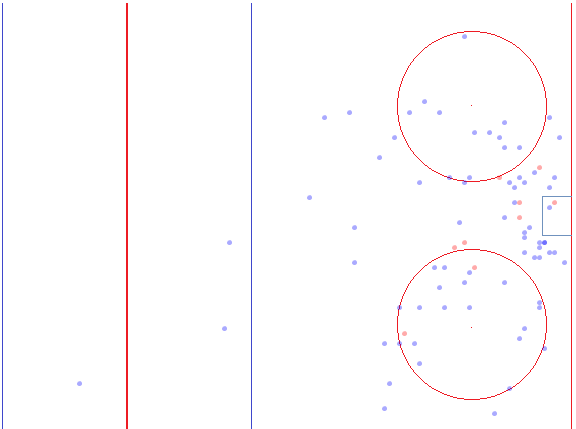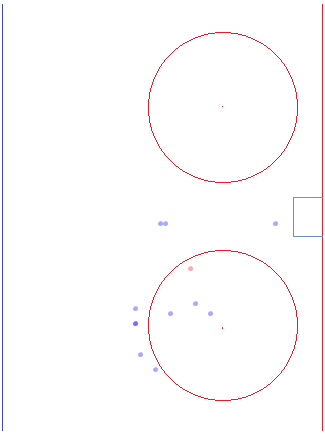When Brian Burke took over the GM job in Toronto, there was nothing but talk about building from the net out. A defence first philosophy is a valid one, though recent Stanley Cup winners have shed light on the benefits of fast offence. Ultimately, Burke’s initial plan was sidetracked by players like Mike Komisarek and Colby Armstrong. It should therefore have come as little surprise to see Burke dip back into the defensive forward game, snagging Jay McClement for an AAV of $1.5 million.
McClement comes with more defensive pedigree than Colby Armstrong ever did. Avalanche fans were noticeably upset with his departure. In anticipation of the (hopefully) upcoming Maple Leafs training camp, I’ve decided to delve into the depths of McClement’s stats in order to properly gauge expectations for the (hopeful) 2012/13 season.
Proper Expectations for McClement’s Offensive Output
First off, here are McClement’s basic stats for his entire NHL career:
| Season | Team | GP | G | A | PTS | PIM |
| 05/06 | STL | 67 | 6 | 21 | 27 | 30 |
| 06/07 | STL | 81 | 8 | 28 | 36 | 55 |
| 07/08 | STL | 81 | 9 | 13 | 22 | 26 |
| 08/09 | STL | 82 | 12 | 14 | 26 | 29 |
| 09/10 | STL | 82 | 11 | 18 | 29 | 22 |
| 10/11 | STL | 56 | 6 | 10 | 16 | 18 |
| 10/11 | COL | 24 | 1 | 3 | 4 | 12 |
| 11/12 | COL | 80 | 10 | 7 | 17 | 31 |
McClement’s 17 points this year was actually the lowest point total of his career thus far. Before flipping out, keep in mind that these 17 points place him 9th in scoring among Avalanche forwards. Colorado was by no means an offensive powerhouse, finishing 25th in the NHL for goals per game (2.43). Colorado had 11 forwards this season with at least 40 games played. Among them, McClement’s Relative Corsi ranked 10th at -11.2. As Corsi is a possession stat, it is logical to assume that prolonged pressure in the offensive end will be a rarity for McClement with the Leafs.
In some other basic metrics, McClement did well. Again among forwards on Colorado, Jay was second in blocked shots (54), fifth in takeaways (34) and third among frequent centers in faceoff percentage (51.3%).
Being a primarily defensive forward, McClement may have been assumed by some to fit into Burke’s toughness mold. This is not the case. He is by no means a pushover, but fights are highly irregular for the 6’1″ forward. Hits, though not nearly as rare as fights, are somewhat scarce as well, with McClement racking up 72 in the 2011/12 season. More importantly, however, is McClement’s propensity to drive into the dirty areas in the offensive zone. Here are McClement’s shots and goals at even strength this season, courtesy of Super Shot Search:
Most of his goals this season were within a few feet of the goal line, no doubt a welcome personality trait in Leafland. He has a similar inclination when on the penalty kill:
This sort of play is a sight for sore eyes for this Leaf fan at the very least. All in all, I think we can expect a marginal bump up in offensive production from McClement, as some of his possible linemates include Nik Kulemin, Clarke MacArthur, Tyler Bozak, Matt Frattin and Nazem Kadri. Just don’t expect the world from him.
Penalty Overkill
Alright, enough beating around the bush. The real reason everyone’s reading this article is for this section right here. Avs fans were remiss when expectations of McClement’s departure became the norm. Leafs fans are no doubt wearisome of claims of defensive superiority, so I’m here to dissuade many of those fears. The stats back up much of what has been said of McClement. Here are a few basic fancy stats from him:
| Season | SH TOI/G | Def. Fin % | GA ON/60 | GA OFF/60 | MA ON/60 | BF ON/60 |
| 08/09 | 3:50 | 45.7% | 5.82 | 5.69 | 21.7 | 31.5 |
| 09/10 | 3:44 | 36.7% | 4.32 | 4.47 | 25.1 | 26.8 |
| 10/11 | 3:00 | 36.2% | 7.14 | 8.14 | 25.0 | 26.4 |
| 11/12 | 3:06 | 37.3% | 4.50 | 7.30 | 23.3 | 27.5 |
SH TOI/G = shorthanded time on ice per game; Def. Fin % = percentage of shifts which ended in the defensive zone; GA ON/OFF/60 = goals against when the player was on/off the ice per 60 minutes played; MA ON/60 = missed shots against when player is on the ice per 60 minutes; BF ON/60 = shots blocked by the player’s team when he’s on the ice per 60 minutes
His 3:06 SH TOI/G is by far the highest on the Avalanche among forwards. Gabriel Landeskog came in second with 1:20 per game, for comparison. League wide, McClement is third in shorthanded ice time among forwards, behind only Max Talbot and Tomas Plekanec. He was second behind Sammy Pahlsson in 08/09 and was first in the league in 09/10.
As for his defensive zone finishes, McClement compares favourably around the league. New Jersey had the top penalty kill in the NHL last season with an 89.6% record. Comparing their PKers to McClement, we see Dainius Zubrus (NJ’s forward leader in SH TOI/G) with 43.2% defensive zone finishes. New Jersey’s second highest forward leader in ice time while shorthanded was Zach Parise, who ended the season with 35.8% defensive zone finishes. McClement does a superb job getting the play to move into the neutral and offensive zones while shorthanded, an invaluable characteristic on a Toronto team with rather woeful goaltending. Once out of his zone, McClement finds some time to add a tiny bit of offence as well. He was the only center on Colorado with a PK on-ice shooting percentage above zero at 5.41%.
He also has a positive difference for his goals against rating in each of the last three seasons, culminating in a rather impressive +2.80. Among forwards who averaged at least 1 minute of shorthanded time on ice per game on the Avalanche, McClement’s GA ON/60 ranks the lowest. Ryan O’Reilly was second with 5.76. He similarly leads in both the missed shots against and blocked shots for categories. What this tells us is that McClement has the ability to push the opposition into weaker areas of his defensive zone, setting them up with bad angles which lead to missed and blocked shots.
Now, in a more circumstantial case, we can look at the Avalanche before and after acquiring McClement. Colorado’s penalty kill was 12th in the NHL in 2011/12 at 83.0%. In 2010/11, when McClement played only 24 games for the Avalanche, they sat at 30th in the league at 76.1%. In 2009/10 they were 21st (80.2%), in 2008/09 they were also 21st (79.9%) and so on and so on. One might think that a jump from 76.1% to 83.0% isn’t very significant. However, if we were to apply this season’s PK% to last season’s, the Avalanche would have been scored on 22 fewer times on the PK. This is by no means McClement alone. The introduction of Semyon Varlamov and a rejuvenated J.S. Giguere helped a franchise marred by awful goalies in the last several seasons. However, McClement was clearly a very important cog in the defensive matrix of the Avalanche shorthanded and lo and behold they jumped several spots in PK%.
McClement is very much as advertised when it comes to his play when a man short. He effectively routes offensive pressure to weak areas, allowing for counterattacks. Unsurprisingly, his goals against are much lower than his peers as a result. He was an integral piece in a new Colorado penalty kill. He does this all while playing some of the largest PK times in the league. Toronto needs a few more McClements.
… and the Ugly
Of course, no player is perfect. Aside from his low offensive output which was discussed previously, a few issues come up in his advanced stats. At even strength his possession numbers are poor (Corsi REL of -11.2). He takes more penalties than he draws, at 0.9 taken per 60 to 0.6 drawn. His Quality of Competition is low at even strength, which make his possession numbers stand out more. One redeeming factor in his possession is that Colorado was actually using him effectively as far as zone starts go, with McClement starting a measly 34.3% of his shifts in the offensive zone. With a postive difference of +13.2 for starts/finishes, there is some measure of good to be had there. Obviously McClement is no sniper in the making, but there is very little about his game that could be categorized as a glaring flaw.
What Others Are Saying About Jay McClement
The Penalty Kill looks less powerful with the loss of McClement and the addition of nobody who kills penalties. – Brett Shumway, Mile High Hockey
“There is no doubt in my mind that Jay McClement is a very competent hockey player who can play excellent in the defensive end.” – Cam Charron, The Leafs Nation
“We like the fact that he’s an established third-line guy with skill. He’s good on face-offs, can kill penalties, last minute of the game, last minute of each period when protecting a lead he’s the guy who’s going to see the ice. Quiet guy, leads by example, he’s not a vocal leader, but we knew he was a good addition.” – Brian Burke
Conclusion
Proper expectations are important for McClement. He’s very good when it comes to killing penalties, that much has been established. This is certainly an organizational need for Toronto, especially with the goalie situation being what it is. At the same time it’s difficult to expect anything beyond the PK. At such a low contract salary, McClement’s use as a special teams guy is justifiable. I imagine that one of Bozak or Connolly will be his wingman on the first unit, with Steckel going to the second, which seems like a smart move. For a team in desperate need of fewer goals against, it’s hard to be upset with the signing of Jay McClement.
@MLHS_Joe



















![Two Down, Two to Go for the Maple Leafs – MLHS Podcast EP91 [Now with Video]](https://mapleleafshotstove.com/wp-content/uploads/2025/04/maxresdefault-3-218x150.jpg)


















![Two Down, Two to Go for the Maple Leafs – MLHS Podcast EP91 [Now with Video]](https://mapleleafshotstove.com/wp-content/uploads/2025/04/maxresdefault-3-100x70.jpg)
